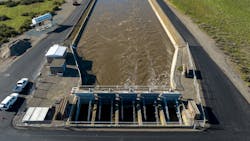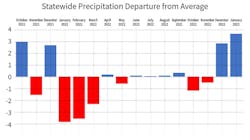California’s recent storms to allow 5% more in water allocations
California’s Department of Water Resources (DWR) announced that recent storms will allow the State Water Project (SWP) to boost deliveries to 29 public water agencies serving 27 million Californians. Based on the amount of water captured and stored in recent weeks, DWR now expects to deliver 30 percent of requested water supplies — or 1.27 million acre-feet — in 2023, up from the initial 5 percent announced on Dec. 1.
The allocation increase is the direct result of extreme weather in late December and nine atmospheric rivers in early January that helped fill reservoirs and dramatically increase the Sierra Nevada snowpack. The SWP’s two largest reservoirs (Oroville and San Luis) have gained a combined 1.62 million acre-feet of water in storage, which is roughly enough to provide water to 5.6 million households for a year. While Water Year 2023 began with below average precipitation, conditions shifted to extreme above average conditions.
The updated SWP delivery forecast accounts for current reservoir storage and is based on a conservative runoff forecast. It does not take into account the current Sierra Nevada snowpack. DWR will conduct snow surveys on Feb. 1, March 1, April 1, and May 1 and may further update the allocation as the water supply outlook becomes clearer with the new data.
In addition to on the ground surveys, DWR will gather data from its Airborne Snow Observatory (ASO) surveys. For the second year in a row, DWR is broadening the deployment of these more sophisticated technologies, such as ASO surveys, that can collect snow measurements farther upslope of the Sierra Nevada.
The data from these flights, which use LiDAR and spectrometer technology to measure snowpack across broad swaths of key watersheds, will be used by DWR to get a more accurate account of California’s snowpack and to update water supply runoff forecasts. Since the storms California experienced this month saw variable snow elevations, the data from ASO flights will help DWR verify snow course and snow sensor data and understand how snow has been distributed across the Sierra Nevada.
DWR cautioned that, while recent storms have been impressive, two months remain in the wet season and California could see a return to warm and dry conditions prior to April 1.
The SWP pumps currently are operating at maximum capacity of 9,500 cubic feet per second and will continue to be adjusted as needed to meet State and federal requirements. However, had the proposed Delta Conveyance Project been in place, the SWP could have stored an additional 202,000 acre-feet of water — enough to supply more than 710,000 households for a year — between Jan. 1 and Jan. 23 while staying within compliance of rules to protect endangered species.
California traditionally receives half its rain and snow by the end of January. Water managers will reassess conditions monthly throughout the winter and spring. Starting in February, the assessments will incorporate snowpack data and runoff forecasts.
Each year, DWR provides the initial SWP allocation by Dec. 1 based on available water storage, projected water supply, and water demands. Allocations are updated monthly as snowpack and runoff information is assessed, with a final allocation typically determined in May or June.
The lowest initial SWP allocation was zero percent on Dec. 1, 2021, with limited water designated only for any unmet human health and safety needs. Last year’s final allocation was 5 percent plus unmet human health and safety needs. Four of the 29 State Water Contractors ultimately requested and received additional human health and safety water supply.

